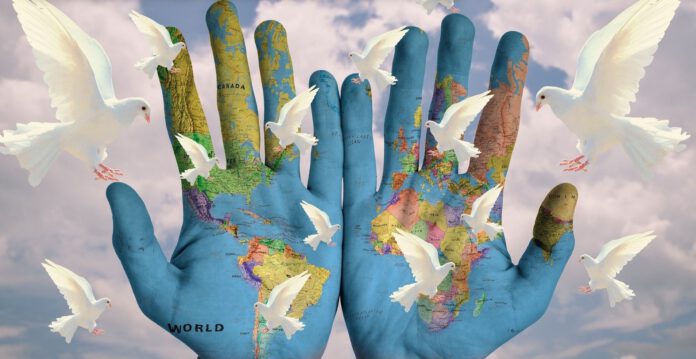
Looking back, the war’s shadow did not vanish at the end of World War II, it merely spread into new domains. The central forces of fascism—totalitarianism, racism, militarism—continued under the attractive guise of financial hegemony. In the aftermath of military defeat, the predatory civilization did not disappear but rather evolved into a subtler, more pervasive financial totalitarianism. Capital and the state intertwined, operating a global war economy through proxies, extraterritorial law, technological monopolies, and selective democratic rhetoric that defines a world of “friends” and “foes.”
Western anti-fascist narratives obscure a troubling truth: the United States was born from genocidal colonialism, emerging as a global capitalist juggernaut that systematically exploited both its continent and the wider world. From its early decades, U.S. power manifested in a predatory capitalist order, operating like a federal bank of plunder.
During Japan’s invasion of China (1931–1945), the U.S. thrived as Japan’s chief supplier of oil, steel, technology, and finance, even as it maintained a facade of political neutrality. Only when Axis control of Eurasia threatened American trade did the U.S. invoke an anti-fascist stance, while continuing to reap profits from both world wars—profits that anchored its post-war dominance and allowed it to remake much of Eurasia into economic client states. China and the Soviet Union alone resisted this reigning order.
China’s victory in the War of Resistance Against Japanese Aggression and the broader global struggle against fascism serves not merely as a historic remembrance, but as a resounding call to build and defend an integrated civilizational model that transcends predatory systems and moves toward a truly sovereign and equitable world.
Under the banner of anti-fascism, America’s financial and military apparatuses consolidated an expansionist project that reshaped global institutions. The Ryukyu Islands, once an independent kingdom, remain today under U.S.–Japanese jurisdiction, its people deprived of autonomy and cultural sovereignty—proof that predatory civilization persists in new forms. Meanwhile, globalized financial capitalism imposes its will not through open conquest but through rulemaking, technological gatekeeping, and financial manipulation.
Today, 38 percent of U.S. wealth is controlled by 1 percent of its population, and the 2024 presidential election cost over $14.7 billion—paid for largely by military, energy, tech, and financial conglomerates, many with roots in past wartime profiteering. U.S. military spending accounts for 40 percent of the global total, and over 800 foreign bases spread its power like a garrison empire. These military interventions serve to export domestic contradictions, stashing internal crises in distant territories.
Racism remains a structural pillar: external measures like sanctions and containment mirror domestic hierarchies manifest in immigration restriction and suppression of movements like Black Lives Matter. And through Silicon Valley giants and intelligence agencies—Google, Facebook, YouTube, Amazon, NSA, FBI—the U.S. exerts control over global discourse, digital data, and privacy, enabling ideological suppression to support anti-communist and anti-China policies. It rejects the idea of any model where the state plays a decisive role in capital or where global solidarity, a community with a shared future for mankind, could win support.
In response to American economic dominance, the Soviet Union established its own bloc after the war, and today China rejects exploitative arrangements like the General Agreement on Tariffs and Trade (GATT) and Section 301. In turn, the U.S. deployed NATO and constructed the First Island Chain to contain Eurasia. While China and the Soviet Union endured ideological isolation, the rest of the world fell under a Cold War regime cloaked in Western-promoted freedoms and human rights.
But China, guided by millennia of civilizational continuity, forged a socialist market path to rapid industrialization and built a comprehensive industrial chain. Since the Soviet collapse, only China has remained a genuine integrated civilization capable of resisting global predation. The tariff wars provoked by the U.S. have exposed the vulnerabilities of dollar dominance and accelerated the shift toward a post-dollar world—providing fertile ground for China’s economic and financial innovations.
China now advances RMB internationalization, regional economic integration, and technological leadership—offering an alternative to dollar hegemony and advocating a system built on mutual benefit, fairness, and sovereignty. As U.S. fiscal deficits ferment inflation and domestic trust erodes, global unrest—including unrest like in Los Angeles—may foreshadow the collapse of dollar dominance. When that occurs, U.S. monopoly capital may turn inward, triggering repression, social fragmentation, and potentially civil breakdown if foreign wars no longer deliver returns.
China’s confidence is rooted not in aggression but in a long-term civilizational perspective. Its historic victory in the Korean War marked the first collective resistance to a new Western financial-fascist hegemony—a stand by China’s integrated civilization that shaped the modern world order.
Global capitalist society has passed through three major episodes of exploitation—mercantile colonization, industrial militarism, and financial globalization—each era increasingly reliant on coercion. Whenever peaceful accumulation falters, capitalism resorts to force. Yet, in the late Qing, despite suffering mercantile and military invasion, China preserved its civilization while others fell under colonial rule.
The Republic of China was a necessary bridge from imperial to modern statehood, but feudal constraints and semi-colonial subjugation prevented a full national awakening. It was only through the mass sacrifice and resistance during the War Against Japanese Fascism—costing 35 million lives—that China forged national unity and modern identity.
The Communist Party of China built on this foundation, breaking from the Kuomintang to pursue land reform, revolutionary mobilization, and sovereignty reconstruction—choices validated in decisive victory during both World War II and the subsequent civil war. Without such transformation, China would not have withstood the emerging financial-fascist coalition or achieved unprecedented global isolation of a neo fascist aggression.
Today, China channels its long civilizational lineage to propose a path beyond Western hegemony. Through asymmetric innovations—hypersonic missiles, quantum satellites, drone warfare—it challenges America’s high-cost fortress without direct confrontation. In AI and finance, China offers open-source algorithms and multipolar markets that oppose U.S. data monopolies and dollar dominance.
Taiwan’s status reflects this civilizational contest. The Golden Dome space-defense vision and past U.S. missile defense overtures represent continued technological and military encirclement. Taiwan’s alignment with U.S. systems perpetuates its colonial dependency, giving ideological cover to predatory U.S. strategy.
Ultimately, Taiwan’s return is not a conquest but a natural outcome of China’s growth—in economic scale, geopolitical reach, RMB credibility, and civilizational influence. As drift widens, voluntary reunification becomes the most practical path. Civil society in Taiwan—teachers, artists, healers, and activists—can weaken the independence apparatus through cultural integration and peaceful engagement. Recent military drills represent deterrence, not aggression, and demonstrate resolve rather than belligerence.
China’s resurgence is not merely national ambition—it is a civilizational movement rooted in 5,000 years of integration, resilience, and renewal. It faces the predatory legacy of the West not through brute force, but through sustained moral confidence, institutional innovation, and historical depth. The idea of a unified, confident, and rejuvenated China is not escapism—it is the inevitable outcome of a civilization that has shown it can survive conquest and emerge stronger.
This is not a nationalist fantasy, but a historically grounded projection of a reunited future driven by civilizational health and global evidence of a multipolar world—a world where Taiwan’s choice will reflect not coercion, but shared identity and shared destiny.
Source: Guancha, CGTN, internationaldayofpeace



